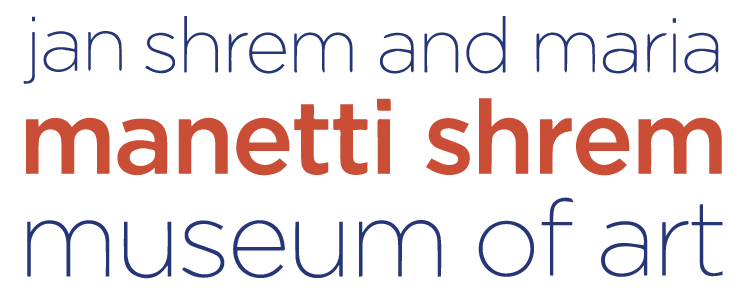At Home with Robert Arneson
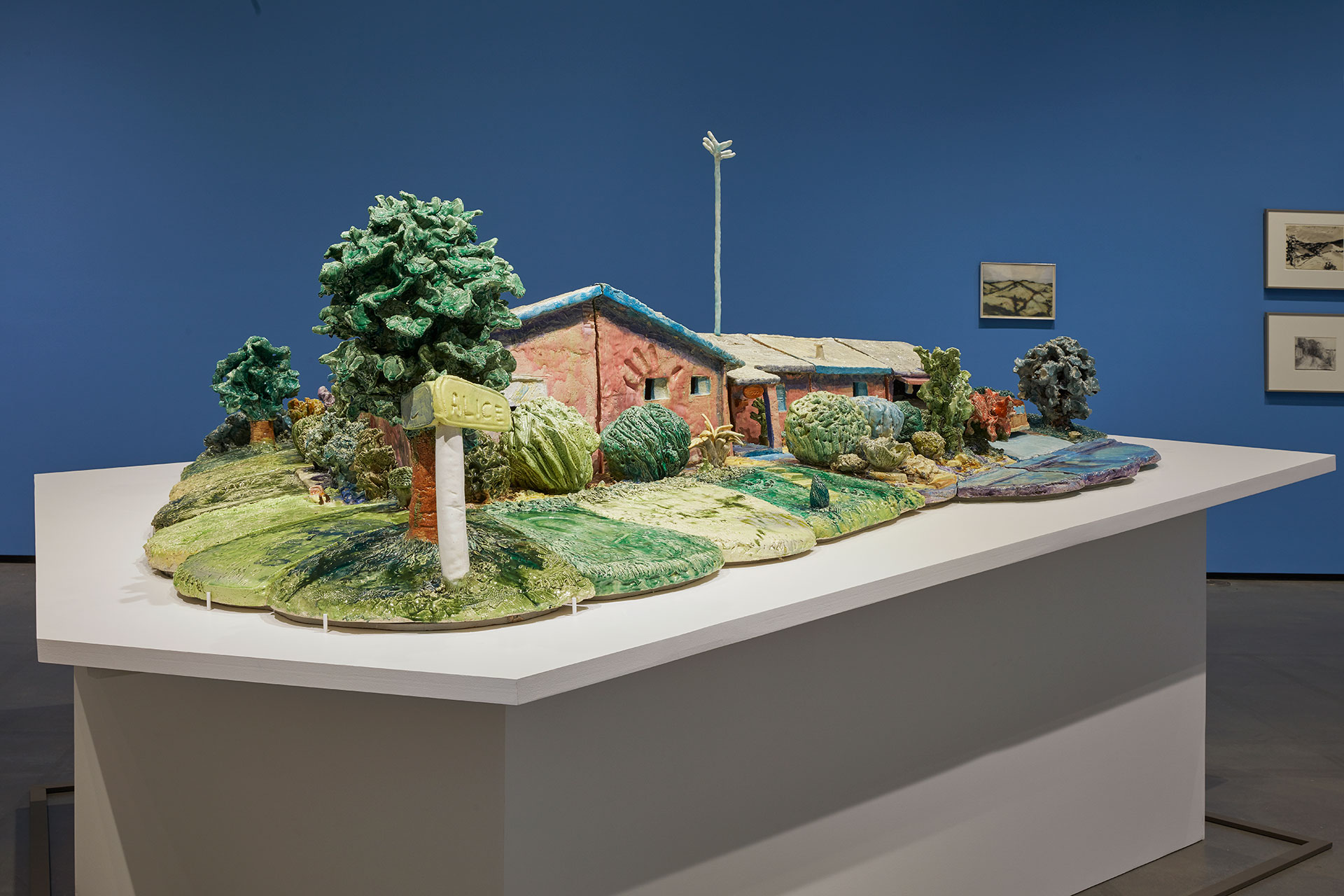
At Home with Robert Arneson
By Simon Sadler
This essay by UC Davis professor Simon Sadler about Robert Arneson's The Palace at 9 a.m. was first published in the 2007 catalogue for You See: The Early Years of the UC Davis Art Faculty. Arneson’s Palace was last shown at the museum in fall 2019 as part of Landscape Without Boundaries.
After a sojourn in storage, Robert Arneson’s monumental, colorful ceramic sculpture The Palace at 9 a.m. (1974) has re-emerged, charming yet enigmatic.1 What is most striking to me, as an architectural historian, is the artistic investment that Arneson poured into the exceedingly ordinary house the piece depicts, in the regular college town of Davis, in the least feted region of California. That abstraction of the extraordinary from the ordinary is what preoccupies this essay. We are shown a normal, but specific house: the piece, sitting atop a bespoke tabletop like an architectural model,2 pinpoints its referent. It is the artist’s own home, 1303 Alice Street, Davis, at the junction with L Street, a private residence that still stands, tidily, in its congenial, middle- class neighborhood.3 Arneson called his house “Alice.” A large ceramic dog bowl by Arneson, found by the current occupants in the garden of 1303 Alice Street along with other stray ceramic pieces, was likewise dotingly stamped “Alice.” “Alice was terrific, Alice in Wonderland,” Arneson said in 1981, as though anthropomorphizing the building.4 Akin to the sort of detail that we might expect to find in a model village, The Palace at 9 a.m. includes the bicycles needed for the Arneson family to get around this avowedly bike-friendly town; it includes the family van, its license plate altered to read TB-9, the building number of Arneson’s campus workshop at the Art Department of the University of California, Davis, then enjoying a heyday.5 A cabriolet sports car waits in the garage. The details typical of domesticity proliferate—logs for the fire, two cats at their bowl—but they are offset by overscale stamps of intense individuality—deep handprints across the walls and roof, a footprint, a shoeprint. The scene is regular, then, but also particular; realistic, and also surreal, with its distorted perspectives and proportions, its expressive modeling, its impress by the artist’s body.
A home is the center of the everyday, which is a quality mostly absent from the basic architectural history survey course that undergraduates in Arneson’s former department at UC Davis currently receive.6 Probably the closest comparison to their own homes that students see during the survey course are images of historic country houses, like Thomas Jefferson’s Monticello in Virginia (1770-1809). Some of the ideals of that iconic American home are reproduced somewhere in the average Davis house, like 1303 Alice Street: modesty; the intimacy of family life; an escape from urban commotion; a friendly relationship to the ground, and to the agrarian economy (one drawing in “Alice” series presented the house framed by plump tomatoes).7 Jefferson’s domed octagon acted as his home’s receptor to the environment at large; Arneson’s extended TV antenna performed that same service, after an intervening century-and-a-half of stark technical innovation that changed American society’s relationship to its geography at large.
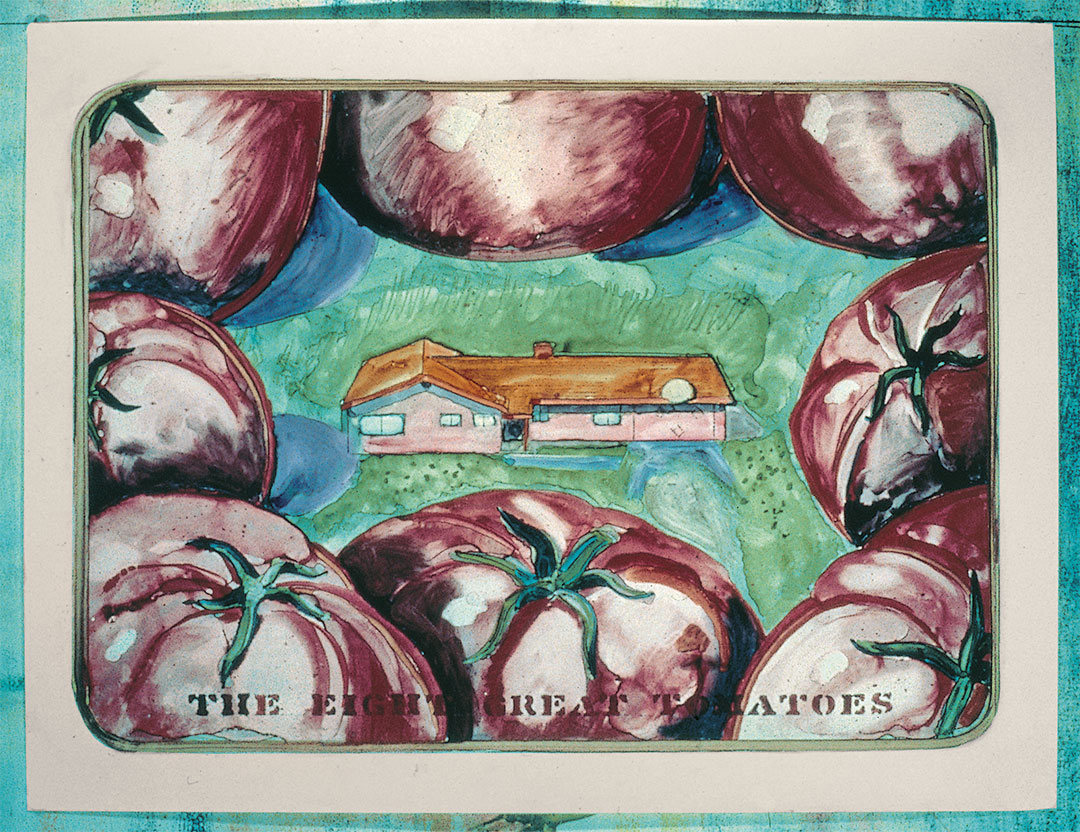
Whereas Jefferson had the luxury of building Monticello around his Palladian tastes, sitting atop a conceptual “ley line” back to the ancient world, there are few architectural or philosophical pretensions at Alice Street that would be recognizable to Jefferson. Its occupants are just occupying, making themselves comfortable, making as small a statement about it as possible. Bob Arneson had to adapt himself to what was basically a mass-produced unit of space, a 1950s tract house much like the other tract houses arrayed around the junction of Alice and L Streets. Occupants of 1303 Alice Street have improved their home not, as Jefferson did at Monticello, through grand interventions such as the adding of a portico, but by redecoration, the conversion of the garage for habitation, the addition of central heat and air, and replacement glazing. In the summer of 1969 Arneson, already quizzical whether ceramics was an art or craft, merged his studio practice with that great American hobby of homemaking, Do-It-Yourself. He fitted three thousand ceramic tiles of his own making at 1303 Alice Street, an enterprise that ended in near-catastrophe when the old vinyl floor caught fire during removal.8 With the installation of the tiles the Alice series took an extraordinary inward turn, art working both within and without the house, large, unique, brown-glazed blocks running through the hallway, kitchen and living areas; white-glazed, amorphous, interlocking tiles creating a splashback; rustic, stone-like ceramics providing a panel in the porch. The house number, “1303,” was modeled by Arneson in simple, rounded, naïve figures. The ceramics are a palimpsest for the life of the house, registering the drawings of Arneson’s children, finger indentations, and most remarkably recording, in the characteristic Arneson letterpress typeface, the weather as Arneson worked (without air conditioning): “August 5 1969 A very windy day” “August 3 1969 Its so fucken hot today” [sic].
The Palace at 9 a.m. sculpture, meanwhile, is describing to us the ordinariness of occupying a mass-produced house and turning it into a home (that distinction of house and home is an idiosyncrasy of the English language). The twelve-foot scale, climactic composition and dramatic false perspective of The Palace piece are ironic, because while Arneson establishes an ideal viewing position for his composition, emulating the country house architects of history, really he knows that he cannot make Alice attain Baroque grandeur. Too much of Arneson’s house was built of planar chipboard for it to attain the stature of sculpture, a fact affirmed by Arneson himself in the deadpan initial studies of the front elevation of the house.9 According to the dominant definitions of architecture, the sort that still govern much teaching, a distinction exists between “building” and “architecture.” Buildings are everyday and ordinary; architecture, as a quotation from a standard student textbook reminds us, differs in “scale, order, permanence, or purpose.”10 In other words, buildings such as palaces qualify as architecture, whereas tract houses do not. By turning a tract house into a palace, Arneson is expressing the disproportionate importance of this humble and anonymous house in the unfolding of his own life and art. Details that would pass by any observer other than the house’s occupant are purposively conveyed by Arneson’s sculpture. A Baroque architect would employ dramatic settings to position viewers as though they were so many members of a theater audience, but the spaces Arneson creates around the The Palace at 9 a.m. convey a much more personal, psychological condition. He has found it is possible to create an intense relationship with suburbia, with the extreme familiarity of its spaces and rituals, with the life around the kitchen sink and bedroom that is rarely commemorated by artists and architects. Do we need “architecture” in that qualitative textbook sense to experience the good life?
Not according to the American Dream, first so-named by James Truslow Adams in his 1931 book The Epic of America, and often defined after the Second World War as the desire for owner-occupation, attendant with family and automobile. The very ordinariness of the American Dream tract house, as American as apple pie—a wedge of which apparently constitutes part of The Palace’s corner lot—had made it suspect amongst many urban critics, sociologists, artists and the like. The pink Arneson house, and its social constituency, correlates almost exactly with the “Little Boxes” derided by Berkeley doctorate-holder and social activist Malvina Reynolds, in the song made famous by performer Pete Seeger in 1962:11
[...]
There’s a pink one and a green one
And a blue one and a yellow one
And they’re all made out of ticky tacky
And they all look just the same
And the people in the houses
all went to the university
Where they were put in boxes
and they came out all the same
[...]
And the children go to summer camp
And then to the university
Where they are put in boxes,
and they all come out the same [...]
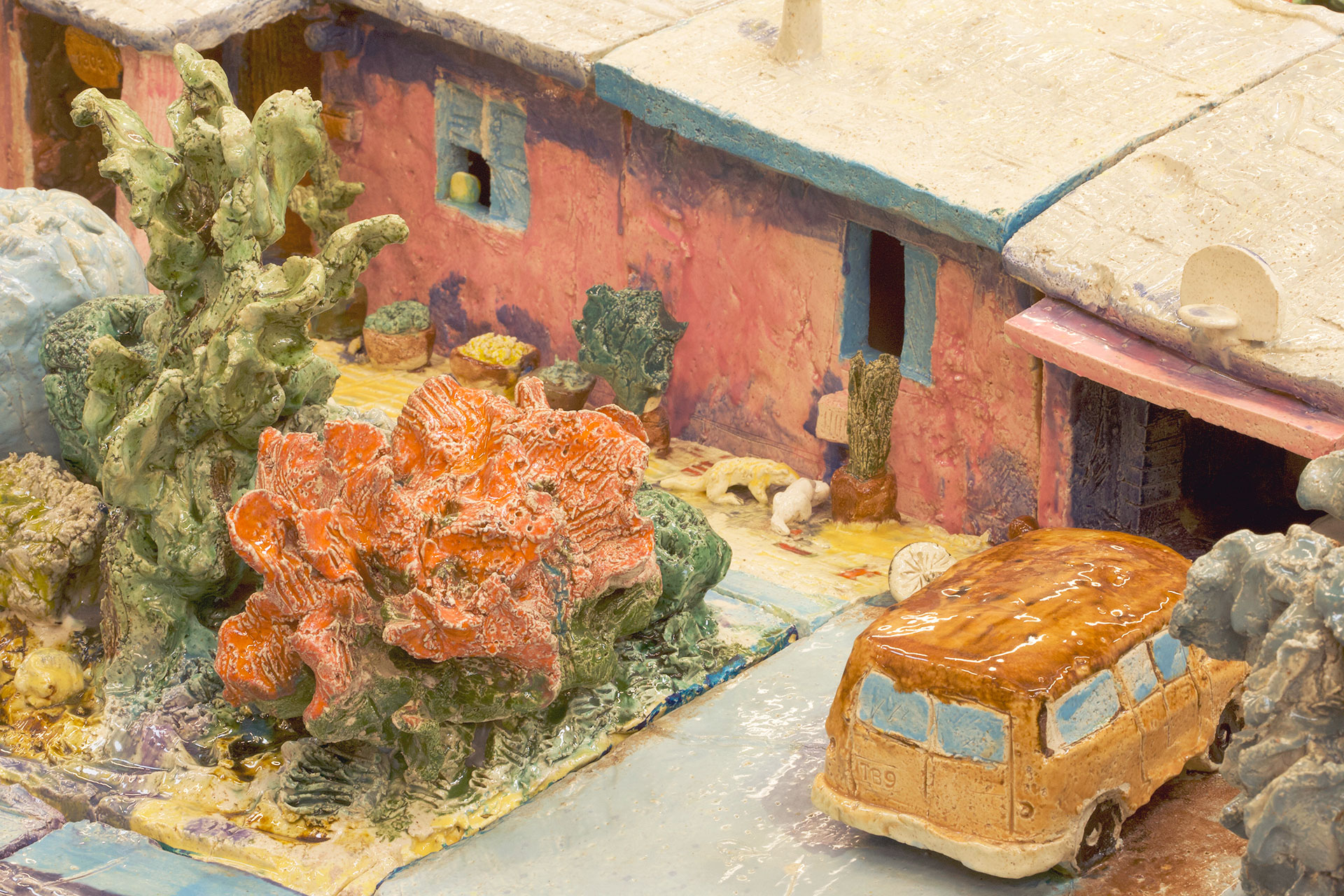
Some post-war intellectuals, gravitating from Beat to counterculture, from communism to the New Left, sought the counter-form of all things suburban and collegial. Others sought grander expressions of civic life, through heroic Beaux-Arts and Modernist buildings, urging the middle classes to return to downtown and become public men and public women again. But by the 1960s and early 1970s, intellectuals were occasionally rationalizing the mute liking that they felt for the suburbs, or at the very least were paying attention to the environments shaping the lives of most Americans. To offer an historical instance of his, the sociologist Herbert Gans put his academic credibility on the line by buying an example, in 1958, of the archetype of post-War tract housing suburbia—Levittown, near New York City—and there he charted for two years the way that he lived in and enjoyed Levittown, for better or worse.12 Gans was on the faculty at the University of Pennsylvania,13 where the architect Denise Scott Brown trained en route to becoming a doyen of postmodernism. Architectural postmodernism was a movement that welcomed ordinariness to the humanities. With her architectural partner and husband, Robert Venturi, Denise Scott Brown impressed upon architects that ordinary lives do not necessarily want for architecture that differs in “scale, order, permanence, or purpose,” as the textbook description would have it: good domestic building might be of the scale, order, permanence, and purpose suited to cooking and shooting hoops, and so could by definition qualify as architecture. The hoop (now freestanding at 1303 Alice Street) is a prominent motif of the pieces in the Alice series (in one drawing, fastidiously measured alongside all the other built elements),14 and like Venturi and Scott Brown at their 1961 Guild House senior citizen accommodation in Philadelphia, Arneson made an unabashed feature of his TV antenna.
From Penn to Davis, faculty who spend their working hours researching very extraordinary things are content to go home to the ordinariness of hoop and TV. In the decade prior to the making of The Palace at 9 a.m., Pop Art reappraised everyday American life. Arneson’s work broadly conforms to Pop: the tract house, alongside Campbell’s soup cans, comics, and the Stars and Stripes, was indeed an emblem of serially-produced America. Despite the seeming indifference of Pop paintings and sculpture, they often resonated with traces of intimacy with the mass-produced object. Arneson’s sculpture is no different. In his sculpture, he did something one would think is impossible, which was to impart a tactility, an impasto, to the improbably bland building materials of the tract house (plasterboard, chipboard, 2x4, stucco). But in this overwrought engagement with his tract house, it is obvious that Arneson himself has no intention of being serially processed by 1303 Alice Street, of getting put in a box (to paraphrase the Malvina Reynolds lyric) and coming out the same as his neighbor. Arneson was a prominent member of an edgy sub-species of Pop Art known as California Funk, comprised of artists who “reveled in their marginal status.”15 In the Alice series, Arneson confesses to being several sorts of person at once, all of them ostensibly incompatible with one another. He is an upstanding faculty member on the one hand, commuting from house to campus by van, and he is a legatee of Beat on the other, championing a “primitive” handing of terracotta and ceramic. He is political in certain respects (a point to which we return below), but a scatological joker in other respects 16 (Arneson became notorious in part through sculptures like the lavatorial Funk John of 1963, and works from 1966, concurrent with the beginning of the Alice series, depict toilets in the landscape, as though the houses which ought to surround them would be little more than a prudish wrapping for the base routines of life).17
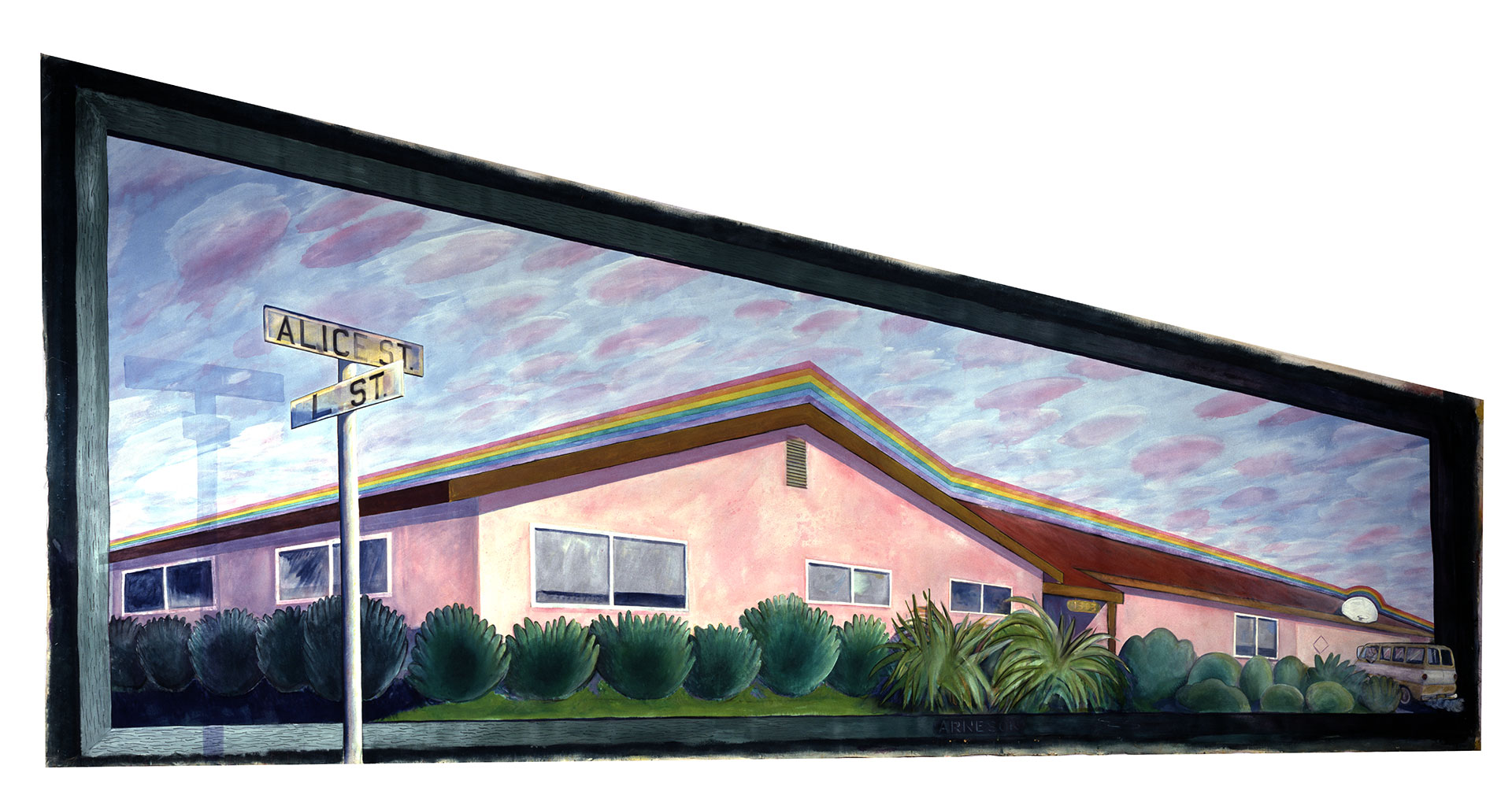
That Funk Art admitted the acquisition of knowledge through the body, and through altered states of mind, is apparent in The Palace’s sense of corporeality and surrealism. If it is not quite possible to read Arneson’s Palace iconographically, step by step, from handprint to footprint, it’s because it contains things too personal, too deeply rooted in the psyche, for the outside observer to interpret: the Alice house “assumed a persona for the artist”.18 In naming the piece The Palace at 9 a.m., Arneson makes an homage to Alberto Giacometti’s sculpture The Palace at 4 a.m. (1932-3), a work which he saw alongside his own at the 1968 Museum of Modern Art show in New York, “Dada, Surrealism and Their Heritage.”19 Given the absence of any substantial grounds for formal comparison between the two pieces (one is almost immaterial, the other is massive) Arneson impels us to wonder whether the affinity set up between the two must be conceptual. Despite the seemingly literal quality of The Palace at 9 a.m., Arneson signals, it refers to the space of his dreams and his being, matters explored in more abstract fashion by the surrealist-existentialist sculptor of The Palace at 4 a.m., Giacometti. It is as though the dream-like perspectives, and drama, and tactility of the exterior of Arneson’s little house are struggling to express the besieged human existences going on within. Pop Art was conventionally considered to be apolitical, a reasonable but problematic assumption that is all the more awkward in regard to Funk.
The Palace at 9 a.m. certainly is not political in any overt way, but its hallmark avant-garde technique of “defamiliarization,” of making familiar things strange, fabricated an aggressive ordinariness that debunked the pretensions of high art. This was an era when many intellectuals wanted to step back from high-minded, idealist projects and metaphorically bring it all back home again—to become grounded again after the upheavals of the 1960s, to take possession of the country after the derangements of American engagement in Vietnam and Civil Rights. This ceramic, the summary form in a series ranging across media, is the most comfortable of the Alice sequence.20 Read against the earlier studies, it’s like waking up again—it’s 9 a.m.—after a rather troubled series of dreams, including one in which Arneson’s house is depicted as Fort Alice (1968), excessively inward looking, too uncompromisingly defended by a palisade, stars and stripes aloft in the year of the Federal Flag Desecration Law, passed as peace activists burned flags on suburban front lawns. In another study from 1968, Alice Blue,21 the house is depicted as a blueprint, a mere factory product, a backdrop to absolute alienation; and in still another work, from the same year, “Alice” is a Billboard, a vulgar real estate product, Cadillac candy-pink with a rainbow eave.22 All of these demeaning aspects of real estate are true of the art world as well, Arneson seems to tell us—introvert, vulgar, vain, commodified. In the 1970s, after the Alice series, Arneson concentrated on self-portraits, of the artist as fallible human, though The Palace is no less of an artist’s self-portrait than Arneson’s figurative works. By putting his absurdly underwhelming home on public display, revealing his address to students and admirers inquisitive about the private life of an art world luminary, Arneson returns us to the enquiry made by nineteenth-century realism into the role an artist plays as a person. This was at its most frank when Arneson confronted the rarified affectation of the New York art world. A prominent instance of this happened when his 1982 self-portrait of a California Artist showed his East Coast critics, who had lately savaged his work, an image of the vacant West Coast artist that Arneson suspected his critics thought he was;23 but more compelling, in a way, was his decision to paint a life-scale, sixty-five foot long portrait of his “ticky-tacky” Davis house while on a 1967-8 fellowship in New York.24
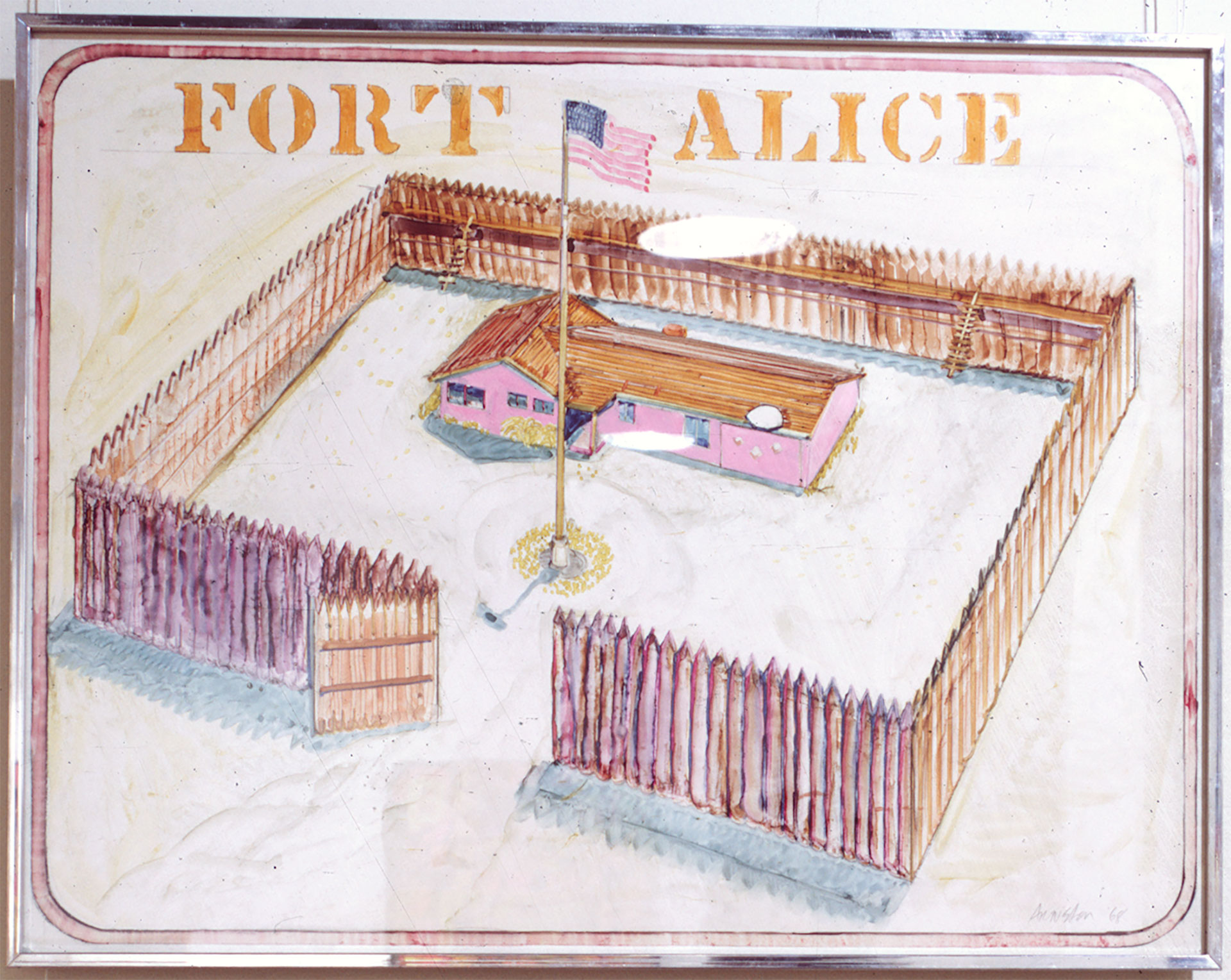
So the “Alice” series discharges several dreams—the collective American Dream; the dream of the person made whole through art; and the dream of an academic life, elevated above the cyclical rhythms of metabolism, family, mortgage and television. All of these dreams, and more, were superimposed by the gradually dying artist in a 1987 lithograph25 in which Arneson imagined the measured elevation of “Alice” doing the best it can to meet the impossible, even infantile desires an occupant has for a house, a childish scribble of a gable-ended house superimposed over it, a fairy castle arising from a thought bubble. The Palace at 9 a.m. (which is the 1974 remake of a version of the piece from eight years earlier, known as Big Alice Street) is probably the least territorial and anxious of the Alice series. It is generous and outward-looking, a nostalgic backward glance (with the break-up of his marriage, the artist had left the house in 1970 and moved to his old home town of Benicia).26 The street sign for Alice and L is prominent in The Palace at 9 a.m., putting “Fort Alice” squarely back into public space, as if the personal is indeed social, reversing the severe introversion that became associated with American suburban life (from, say, Betty Friedan’s 1963 “Problem that Has No Name”27 to the Nightmare on Elm Street horror movie of 1984). An Arneson family member lies on the lawn of The Palace, soaking up the plentiful Central Valley sun unabashed at being in full view of the street.28 With this sculpture, Arneson partially declined his right to privacy in a small college town, where Alice Street, when it was built, still sat towards the eastern edge, the summer dusts of ploughed fields dirtying the screens.
The Palace’s celebration of ordinary life recalled the genre and realist practices of the seventeenth- and nineteenth-centuries: if you want to know what is universal about the human experience, such art showed us, don’t worry about the dome of heaven or the far horizon, but start, like Jan Vermeer, with the simple ballet of pouring water or opening a letter near a window. It’s not quite that straightforward however. Inevitably, as Arneson makes a monument out of his ordinary house, his house stops being ordinary. It becomes a major work of art that deserves the best possible housing it can have—an art museum—and so Arneson makes it possible for us to now savor the irony of encasing a model of an ordinary house within a museum. Had his life not been cut short by cancer in 1992, he would have savored too, one suspects, the irony of Davis becoming somewhere “special,” and not just the pleasant town, just that bit too far from the San Francisco Bay, that provided Arneson with the background to the Alice series. In 1974, Arneson vividly explored ordinariness. Three decades later, giddy from rising house prices while declaring its opposition to sprawl, Davis would become enthralled to a studied ordinariness, wanting to remain an ordinary town, framing itself—like Vermeer framing the opening of a letter—such that it is no longer an ordinary Central Valley town, but a town that sees its Central Valley ordinariness as quite special. (In the words of my auto mechanic in neighboring Woodland, “Davis is weird.”) To make The Palace at 9 a.m. now, with the same meanings, would be impossible. Such a house as this is currently worth in excess of half a million dollars (even without Arneson ceramics in it). Arneson’s darker allusions—of the house as real- estate collateral—are unexpectedly reemerging.
True ordinariness is that which ultimately will not be represented. Witness how Arneson transformed his domestic conformism into unique works of art: The Palace at 9 a.m. is really living a quite different existence to the tract house that instigated it. With Arneson gone from 1303 Alice Street long since, evacuating from it his sometimes joyful, on occasion tumultuous family life, the building remains, anonymously, on Alice at L, its current occupants peacefully living their own everyday lives that are illegible on the outside; so looking at The Palace at 9 a.m. is like inspecting a soul that stepped out of its body.
Professor Simon Sadler teaches the history and theory of architecture, design and urbanism in the Department of Design and the Program in Art History at UC Davis. Read more on Professor Sadler. For a look at his most recent work, visit Places Journal.
- 1My thanks to Renny Pritikin, Jeff Ruda and Bob Riley for inviting me to prepare this essay.
- 2An observation made in Neal Benezra, Robert Arneson: a retrospective, Des Moines: Des Moines Art Center, 1985, p. 27.
- 3My sincere thanks are extended to Robert and Donna Nevraumont, the owners of 1303 Alice Street, for allowing me to visit and photograph the house, and for preserving Arneson’s ceramics there in exemplary condition.
- 4Quoted in An Interview with Robert Arneson, conducted by Mady Jones for the Archives of American Art, Smithsonian Institution, California Oral History Project, August 1981, p. 5, cited in Signe Mayfield, Big Idea: The Maquettes of Robert Arneson,. Palo Alto Art Center, 2002, available at http://www.tfaoi.com/aa/3aa/3aa476.htm.
- 5See the exhibition catalog 30 Years of TB-9: a tribute to Robert Arneson, Davis: John Natsoulas Gallery, 1991.
- 6The philosophy of Henri Lefebvre and Michel de Certeau is of foundational importance to the exploration of the everyday. For a survey of the theory of the everyday, see Ben Highmore, Everyday Life and Cultural Theory: an introduction, London and New York: Routledge, 2002.
- 7Robert Arneson, The Eight Great Tomatoes (Alice Street Series), 1968, drawing, 20" x 26", Fine Arts Collection, University of California, Davis
- 8See Benezra, op cit., p. 29.
- 9See for instance Robert Arneson, Alice Blue, 1968, painting, 40" x 112", Fine Arts Collection, University of California, Davis; and Robert Arneson, 1303 Alice Street (Working on Alice), 1967-68, mixed-media collage on paper, 26” x 20", collection of Sandra Shannonhouse.
- 10Anthony Janson and H. W. Janson, History of Art, sixth edition, New York: Abrams, 2001, p. 40.
- 11Benezra, op. cit., p. 26, alludes to a connection between this song and the Alice series when he describes the Arneson house as “ticky-tacky.”
- 12See Herbert Gans, The Levittowners: ways of life and politics in a new suburban community, London: Allen Lane, 1967. Levittown was far from an ideal, not least because of its de facto color bar, an ignominy addressed in Northern California by modernist developers like Eichler.
- 13My consideration of ordinariness and everyday-ness in post-War America draws on the fascinating volume Architecture of the Everyday, edited by Steven Harris and Deborah Berke (New York: Princeton Architectural Press, 1997), in particular Deborah Harris’s essay “Ugly and Ordinary: the Representation of the Everyday,” pp. 75-106.
- 14Robert Arneson, 1303 Alice Street (Working on Alice), 1967-68, mixed-media collage on paper, 26" x 20", collection of Sandra Shannonhouse.
- 15I borrow this summary from the MIT courseware of Caroline Jones (http://ocw.mit.edu/OcwWeb/Architecture/4-65120th-Century-ArtFall2002/LectureNotes/detail/week6-1.htm). For an insightful reconsideration of Funk ceramics, see Mitchell B. Merback, “Beat Funk, Ceramic Funk, Defunct Funk: a critical flashback”, American Ceramics, vol. 10, no. 4, 1993, pp. 32-37. The founding document of Funk is the 1967 catalog accompanying the exhibition curated by Peter Selz at the University Art Gallery, University of California, Berkeley.
- 16See Merback, op. cit.; see too Steven A. Nash, Arneson and Politics, San Francisco: The Fine Arts Museums of San Francisco, 1993.
- 17See for instance Robert Arneson, Untitled (Toilets in Landscape), 1966, print, 9" x 12", Fine Arts Collection, University of California, Davis
- 18See Benezra, op cit., p. 27.
- 19For an alternative interpretation, which views the Palace as oppressive, see Mayfield, op cit.
- 20Robert Arneson, Alice Blue, 1968, painting, 40" x 112", Fine Arts Collection, University of California, Davis
- 21Lisa Tamiris Becker has pointed out in “Alice Street Revisted” (exhibition brochure, Richard L. Nelson Art Gallery, University of California, Davis, 2000) that the rainbow motif might also refer to the apotheosis of the counterculture.
- 22See Benezra, op. cit., p. 70.
- 23See Mayfield, op. cit., and the chronology in the catalog Robert Arneson: Self-Reflections, San Francisco: San Francisco Museum of Modern Art, 1997.
- 24Robert Arneson, House on Alice XV/ XV, 1987, lithograph, 22" x 32".
- 25See Benezra, op. cit., p. 29.
- 26See Betty Friedan, The Feminine Mystique, New York: Norton, 1963.
- 27This stretch of grass on the L Street side of the house is now fenced in.
- 28This idea is developed in my essay “Everyday People”, Prototypo, vol. 4, no. 7, 2002, pp. 107-111, and in my unpublished paper “The Rise of the Everyday,” at the Symposium “The Aesthetic and the Anti-Aesthetic in Art, Architecture and the Humanities”, University of California, Berkeley, February 2002
